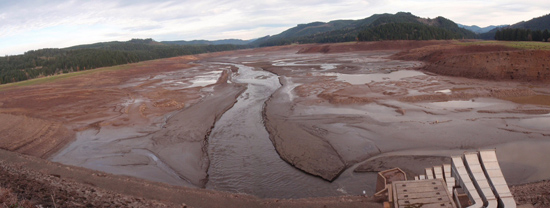February 2013: See findings from research on juvenile salmon passage at several Willamette Basin federal dams, adult fish spawning success, bull trout reintroduction, lamprey research and moreabstracts from the annual Willamette Basin Fisheries Science Review. Link to abstracts here.

12-11-12: A drawdown at Fall Creek Reservoir in the Willamette Basin helps move ESA-listed juvenile fish past the dams through the regulating outlets at Fall Creek Dam. Research has shown that lowering the reservoir pool during juvenile migration results in roughly a ten-fold increase in the numbers of adult salmon that later return to Fall Creek. The operation has been so successful that the Corps is testing it at Cougar Dam as well.
The Willamette River Basin Project is comprised of 13 dams and reservoirs in the Willamette River drainage system, which begins south of Cottage Grove, Ore., and extends north to the Columbia River. The operation of each dam contributes to an overall water resource plan designed to preserve the quality of the valley's environment by providing flood damage reduction, power generation, irrigation, and navigation on the Willamette River and several of its tributaries. In addition, the dams help maintain water quality and support water-related recreation.
On May 31, 2007, the action agencies provided a Supplemental Biological Assessment to NOAA Fisheries and U.S. Fish and Wildlife Service evaluating the effects on ESA-listed fish in operating the Willamette River Basin dams for flood damage reduction and power.
On September 20, 2007, Willamette Riverkeeper and the Northwest Environmental Defense Fund filed a lawsuit against NOAA Fisheries on the basis that the federal government had not produced a Biological Opinion for the Willamette Basin.
On July 11, 2008, the federal government issued a final BiOp for ESA-listed fish in the Willamette Basin. For more information about the Willamette Basin, visit the Corps of Engineers’ Portland District’s Willamette Valley projects website.